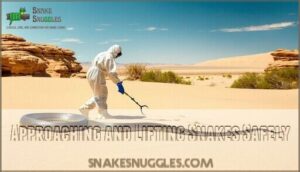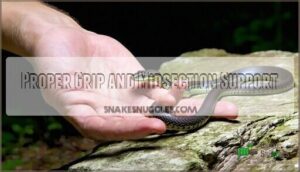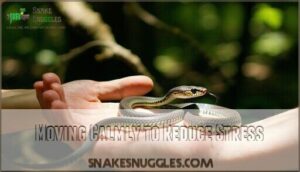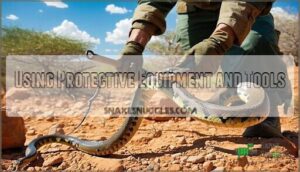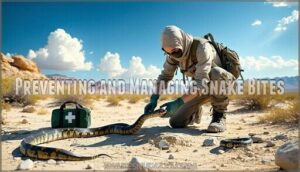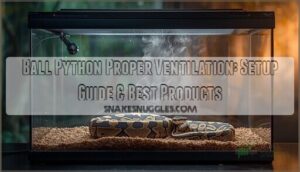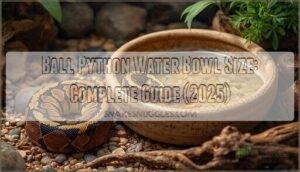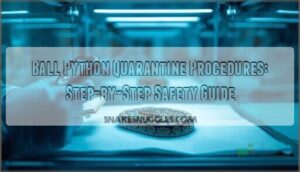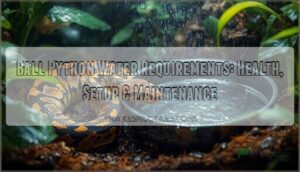This site is supported by our readers. We may earn a commission, at no cost to you, if you purchase through links.
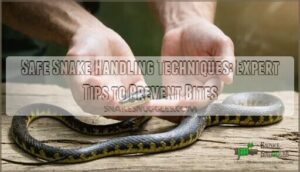
Whether you’re a wildlife professional working with venomous species or a pet owner managing your first corn snake, the same principles apply: respect the animal’s boundaries, use deliberate movements, and never underestimate the speed of a defensive strike.
The difference between confidence and recklessness often comes down to understanding what triggers a bite and having the right equipment within arm’s reach when managing any snake.
Table Of Contents
- Key Takeaways
- Preparing for Safe Snake Handling
- Essential Snake Handling Techniques
- Interpreting Snake Behavior Signals
- Using Protective Equipment and Tools
- Preventing and Managing Snake Bites
- Frequently Asked Questions (FAQs)
- How to handle a snake safely?
- How do you handle a slithery snake?
- How do you handle a venomous snake?
- Why should you care about snake handling & safety?
- How do you handle snakes ethically?
- What is snake handling training?
- How often should snakes be handled weekly?
- What temperature range is safe for handling?
- Can pregnant or juvenile snakes be handled?
- How long after feeding should handling wait?
- Conclusion
Key Takeaways
- Reading a snake’s body language and respecting its boundaries is your best defense against bites.
- Always use slow, deliberate movements and support a snake’s midsection with both hands, keeping clear of the head and tail.
- Match your equipment and safety gear—like hooks, gloves, and enclosure locks—to the species you’re working with to reduce risk.
- Handle snakes only when they’re calm, avoiding times like post-feeding or shedding to prevent stress and defensive strikes.
Preparing for Safe Snake Handling
Before you manage any snake, you need to set yourself up for success. The right preparation keeps both you and the snake safe from the start.
Here’s how to set the stage for calm, confident handling—starting with the must-do basics.
Hand Washing and Personal Hygiene
Washing your hands thoroughly before touching any snake isn’t just good hygiene—it’s your first line of defense against transferring harmful oils, residues, or scents that can stress the animal or trigger a defensive response.
To keep both you and the snake safe, start by following these hand hygiene tips:
- Use soap and warm water for at least 20 seconds
- Avoid hand sanitizers with strong fragrances near reptile touching
- Rinse off lotions or perfumes that mask your natural scent
- Sanitize clean equipment and protective gear before each session
This routine protects both you and the snake.
Choosing The Right Snake Species
Your choice of snake species matters more than you might think—beginners who start with corn snakes or ball pythons report over 90% fewer manipulation incidents compared to those selecting high-strung or venomous snakes. These gentle species dominate beginner snake recommendations because they tolerate manipulation well, rarely bite, and adapt quickly to routine interaction.
Corn snakes account for over 30% of first-time pet snake options, while ball pythons make up 28%, both prized for their calm temperament and predictable snake behavior. California kingsnakes and rosy boas round out the top picks, with bite rates below 2% and consistent manipulation recommendations across reptile care guides.
Starting with a docile species builds your confidence and reduces safety risks for both you and the animal. Understanding the basics of snake care needs is essential for creating a safe and healthy environment for your pet.
Recognizing Safe Handling Times
Timing your interaction sessions around your snake’s natural rhythms—not just your schedule—can cut stress-related defensive strikes by more than half. Safety checks before each session reduce risk:
- Never interact with within 48 hours of feeding—digestion triggers defensive snake behavior
- Avoid shedding periods when vision is impaired and stress peaks
- Skip late evening when nocturnal species enter active hunting mode
- Watch for environmental factors like temperature drops below 70°F
- Assess body language continuously during interaction times
Recognizing and responding to snake behavior patterns transforms interacting with snakes safely from guesswork into risk assessment you can trust.
Enclosure Safety and Escape Prevention
A secure enclosure is your first line of defense against escapes that put both the animal and your household at risk. Proper enclosure design includes secure lids with locking mechanisms, adequate ventilation systems that don’t compromise containment, and snake-proof barriers.
Effective escape proofing requires fence heights of 1.1–1.4 meters with smooth surfaces for outdoor setups. Regular inspection of your snake enclosure prevents gaps that compromise snake safety and wildlife safety alike.
Essential Snake Handling Techniques
Once you’ve prepared your space and gear, it’s time to actually manage the snake.
The techniques you use determine whether the experience stays calm or turns stressful. Let’s walk through the fundamental methods that keep both you and the snake safe.
Approaching and Lifting Snakes Safely
Before you reach for that snake, think of it like greeting a stranger—your approach sets the tone for everything that follows. Move slowly and deliberately, watching for defensive signals like coiling or hissing.
Use a snake hook to maintain distance, then lift from the midsection—never near the head. Gentle management and calm movement reduce stress for both you and the snake, making safe management techniques second nature with practice.
Proper Grip and Midsection Support
Once you’ve lifted the snake, your grip becomes the foundation of control—aim to support about one-third of its body length in your dominant hand, cradling the midsection firmly but without constriction.
Think of it like holding a garden hose—too tight and you’ll trigger defensive responses, too loose and you’ll lose control.
This balanced grip technique ensures proper body alignment while allowing the snake natural movement, a cornerstone of safe management methods that prevents unnecessary stress and keeps you in command.
Using Both Hands for Stability
Two hands aren’t just helpful when managing a snake—they’re your insurance policy against drops, escapes, and the stress that comes with feeling off-balance. Proper dual support distributes the snake’s weight evenly, giving you control while letting the animal move naturally along your arms.
To get the hang of balanced snake handling, there are a few key tips to keep in mind:
- Stable grip with your dominant hand anchors the midsection
- Hand positioning should space 8–12 inches apart for medium-sized snakes
- Weight distribution prevents muscle fatigue during extended management sessions
- Dual support allows continuous contact as the snake explores
- Safe management requires adjusting your hold as the animal shifts
This method defines effective snake management techniques—you’ll feel secure, and your snake won’t panic.
Avoiding The Head and Tail Areas
Your snake’s head and tail aren’t just off-limits zones—they’re the two areas where even a docile animal can react unpredictably if you miscalculate your approach. Head avoidance keeps you outside striking range, while tail safety prevents sudden whipping reflexes that startle both handler and snake.
Focus your snake restraint efforts on midsection body support—that’s where gentle management and proper snake management techniques converge.
Understanding snake behavior patterns helps you recognize when venomous snakes or defensive species need extra distance, making snake safety second nature.
Moving Calmly to Reduce Stress
Think of managing a snake like adjusting a thermostat—gradual changes keep everything comfortable, but one sharp twist can trigger alarms you didn’t mean to set. Calm movement transforms nervous reptiles into cooperative partners. Your slow approach and gentle management techniques reduce stress dramatically:
- Telegraph your intentions with predictable, fluid motions
- Pause between actions to let the snake adjust
- Breathe steadily—your tension transfers directly through touch
- Maintain consistent speed throughout safe interaction
- Watch for relaxation cues confirming successful stress reduction
Snake behavior rewards patience with safer management experiences every time.
Interpreting Snake Behavior Signals
Reading a snake’s body language isn’t guesswork—it’s your early warning system. When you understand what a snake is telling you through its posture, movements, and reactions, you can adjust your approach before things escalate.
Keep an eye out for these signs whenever you’re around a snake.
Identifying Defensive Postures
When a snake coils tight, flattens its neck, or holds its body rigid as a drawn bow, it’s telling you to back off—and ignoring these warnings is how handlers get bitten. Look for defensive signals like an S-shaped strike posture or a gaping mouth—these threat postures mean the snake’s ready to defend itself.
Recognizing snake body language keeps you safe and prevents defensive bites, especially with venomous snakes.
| Defensive Signal | What It Means |
|---|---|
| Tight coiling | Preparing to strike |
| Flattened neck | Intimidation display |
| S-curve body position | Ready to lunge forward |
Recognizing Signs of Stress or Aggression
Beyond those obvious defensive displays, stress signals show up in subtler ways—a snake that’s rapidly flicking its tail, hissing repeatedly, or fixing you with an unblinking stare is broadcasting discomfort loud and clear.
Keep an eye out for these warning signs to help you steer clear of a snake bite:
- Rapid tail vibration or whipping movements
- Continuous hissing or exhaling sounds
- Body held stiffly with visible muscle tension
- Intense, unmoving gaze directed at you
- Refusal to move or explore its surroundings
Recognizing snake body language prevents stress escalation and keeps both you and the snake safe.
Species-Specific Behavioral Cues
Rattlesnakes deliver clear threat displays with audible tail vibrations—all 33 species across the Americas use this warning before striking. Cottonmouths flash their white mouth interiors when cornered, a defensive posture unique to this species. Coral snakes show red-yellow-red banding patterns, signaling venom to alert handlers versed in species recognition.
Many venomous snakes have triangular heads due to venom gland placement, while nonvenomous species usually show slender profiles. Understanding these behavioral patterns and body language differences helps you recognize and respond to snake behavior safely, reducing bite risk through informed snake management techniques.
To improve safety, it’s necessary to study snake species identification methods and guidelines.
Environmental Triggers and Handling Adjustments
Temperature, humidity, and lighting conditions can shift a snake’s mood faster than you might expect—keepers who ignore these cues often pay the price. Climate effects like cold temperatures reduce snake activity, while excessive heat triggers defensive behavior in venomous snakes.
Adjust your snake interaction techniques accordingly: interact during cooler hours, maintain proper temperature control in enclosures, and dim bright lights that stress reptiles.
Habitat considerations and environmental factors directly impact snake safety—respect these triggers and you’ll prevent most bites before they happen.
Using Protective Equipment and Tools
The right equipment transforms snake management from risky to routine. You’ll want tools that give you control while keeping a safe buffer between you and the snake.
Let’s take a look at the essential tools you’ll want on hand.
Snake Hooks, Tongs, and Gloves
A snake hook isn’t just another tool in your kit—it’s the difference between confident control and a defensive strike you didn’t see coming. Snake hooks let you maintain a safe distance while guiding movement, while tongs offer a secure grip for restless specimens.
Puncture-resistant gloves add a protective barrier, though they reduce tactile feedback. Choose equipment based on species size and temperament, and sanitize tools between management sessions to prevent cross-contamination and maintain equipment longevity.
Protective Eyewear and Clothing
Your eyes aren’t just vulnerable—they’re a spitting cobra’s primary target, and the right protective gear turns a potential medical emergency into a manageable encounter. Protective eyewear shields against venom spray, while sturdy boots and puncture-resistant gloves form your defensive apparel foundation.
Snake-proof clothing—long sleeves, thick pants, gaiters—reduces bite risk by over 70% during fieldwork. These safety precautions aren’t optional; they’re non-negotiable insurance against preventable injuries.
Safe Tool Selection for Different Species
Each snake species demands its own specialized tool—a 24-inch hook suits a corn snake, but you’ll need 48 inches and locking tongs for an agitated rattlesnake. Tool material selection matters: stainless steel hooks won’t corrode, while rubberized grips prevent slippage during critical moments.
Venomous snake gear includes collapsible tongs with secure locks, ensuring you maintain a safe distance when managing hot species. Match your management equipment to body size and temperament—species-specific tools aren’t luxury items, they’re survival essentials.
Sanitizing and Maintaining Equipment
Contaminated hooks and tongs don’t just spread bacteria—they can transmit parasites, shed skin pathogens, and disease vectors between your entire collection if you skip proper sanitation.
Wipe down your snake management kit with veterinary-grade disinfectant after every use, then follow maintenance schedules that include monthly deep-cleans. Store protective gear in sealed containers to prevent cross-contamination.
Proper equipment cleaning and disinfection methods aren’t optional—they’re your frontline defense in snake management safety.
Preventing and Managing Snake Bites
Even with the best preparation, bites can still happen—so you need to know how to prevent them and respond fast when they occur. Understanding the difference between non-venomous and venomous bites can mean the difference between a minor inconvenience and a medical emergency.
Let’s walk through the essential strategies that’ll keep you safe and prepared.
Bite Prevention Strategies
The best defense against a snake bite isn’t luck—it’s understanding how your actions either invite danger or prevent it entirely. Bite Risk Assessment starts with Venomous Species Identification and Snake Behavior Analysis before you even approach.
Recognize Defensive Signal Recognition cues—coiling, hissing, or tail rattling—and back off immediately. Protective Gear like gloves and boots adds critical layers of Snake Management Safety.
Emergency Preparedness means knowing your species, having antivenom access for venomous encounters, and never rushing your movements.
First Aid for Non-Venomous Bites
Even non-venomous bites need immediate attention—ignoring a puncture wound from a "harmless" snake can lead to infection, tissue damage, or worse.
Wash the wound thoroughly with soap and warm water to remove bacteria. Apply gentle pressure with clean gauze to control bleeding.
Monitor bite symptoms like swelling, redness, or increasing pain—these signal you need medical treatment. Don’t underestimate nonvenomous snakes; proper first aid and wound cleaning protect you from complications that compromise snake safety.
Emergency Response for Venomous Bites
When a venomous snake strikes, every minute counts—antivenom works best within four hours, and delays can mean the difference between recovery and severe complications.
Here’s what to do right away in an emergency:
- Stay calm and call emergency services—provide details about venomous bite symptoms like swelling, pain, or breathing difficulty
- Remove jewelry and tight clothing near the bite wound before swelling starts
- Keep the bitten limb immobilized below heart level while awaiting medical response
- Don’t apply ice, tourniquets, or attempt suction—focus on getting professional antivenom administration quickly
Medical response timing directly impacts survival, so prioritize rapid transport over first aid attempts.
Legal Requirements and Safety Protocols
Managing snakes isn’t just about technique—it’s about following the law. In 2025, over 90% of licensed managers need government-issued permits for public or private removals, with special licensing for threatened species. Regulatory Compliance and Safety Standards require certified training, proper facility design with dual emergency exits, and strict Species Protection protocols. Emergency Protocols mandate antivenom access for venomous operations, while unlicensed removal can bring fines up to $10,000.
Here’s what you need:
| Requirement | Standard |
|---|---|
| Personal Protective Equipment | Safety toe boots, puncture-resistant gloves, long-sleeved clothing (OSHA mandated) |
| Facility Standards | Two emergency access points, unobstructed egress paths, grilles removable from inside |
| Manager Certification | Accredited courses required in 70% of U.S. states; supervised sessions before venomous species |
Following these Legal and Safety Considerations reduces Liability Reduction risks and ensures Wildlife Safety Precautions. Snake Management Safety depends on Snake Bite Prevention through proper Safety Tips and regulatory adherence.
Frequently Asked Questions (FAQs)
How to handle a snake safely?
Before you reach for any snake, wash your hands and gather the right protective gear.
Safe management starts with slow, deliberate movements—support the snake’s midsection using both hands while keeping clear of the head and tail.
How do you handle a slithery snake?
Approach calmly and lift from the midsection using both hands for secure support.
Keep movements slow and predictable to minimize stress. Snake management techniques work best when you maintain firm but gentle control away from the head.
How do you handle a venomous snake?
If you think managing Venomous Snake Management is just “grab and go,” you’re in for a rude awakening—literally. Only trained professionals should attempt Safe Capture Methods with venomous snakes.
Use snake hooks and protective gear, maintain distance, and prioritize Snake Bite Prevention.
Emergency Response preparation is non-negotiable when working with Venomous Species.
Why should you care about snake handling & safety?
Proper Snake Management Safety and Venomous Snakes awareness protect both people and Wildlife Protection efforts.
Safe Snake Management Techniques with Protective Gear reduce injury risk by over 65%, supporting Snake Conservation through Emergency Preparedness and Safety Regulations compliance.
How do you handle snakes ethically?
Before you pick up any serpent, remember: respect scales the relationship.
Ethical management means prioritizing snake welfare through humane restraint, minimizing stress during capture, and honoring conservation ethics that protect both individual animal rights and species survival in every interaction.
What is snake handling training?
Snake management training teaches you safe management techniques and safety protocols for working with both non-venomous and venomous species.
Certified programs cover behavioral cues, proper equipment use, and emergency response procedures to minimize bite risk.
How often should snakes be handled weekly?
How often should you touch your snake each week? Touching frequency depends on your snake’s temperament and your experience level.
Most adult snakes benefit from 2–3 weekly interaction sessions, each lasting 10–15 minutes, while juveniles may need less frequent touching to minimize stress.
What temperature range is safe for handling?
You’ll want to manage snakes when ambient temperatures fall between 75–85°F. This thermal comfort zone facilitates natural reptile management behavior and safe management techniques.
Temperature control matters—cold snakes become sluggish, while overheated ones grow defensive.
Can pregnant or juvenile snakes be handled?
Yes, but proceed with caution. Pregnant snake care requires extra gentleness, as gravid females are more sensitive and defensive.
Juvenile management and neonate management demand light, careful support—young snakes are fragile but can still bite.
Understanding snake development and reproductive safety ensures managing snakes safely.
How long after feeding should handling wait?
Give your snake at least 48 hours after feeding before you touch it.
This touch wait facilitates proper digestion time, respects natural snake behavior, and keeps both the animal’s metabolism and your safe touch routine in sync.
Conclusion
Managing a snake is like walking along a winding trail—you’ll move confidently by reading each subtle sign and knowing exactly where to step. Mastering safe snake management techniques is a mark of respect for the animal and for yourself; it transforms anxiety into skill.
Mastering snake handling turns nervous uncertainty into practiced confidence, letting you and your serpent move safely and in sync
With steady hands and a careful eye, you create not just a safe environment but a partnership built on awareness. Every safe interaction proves your vigilance is your strongest tool, every single time.
- https://reptilesupershow.com/snake-handling-safety-tips-for-secure-encounters/
- https://pmc.ncbi.nlm.nih.gov/articles/PMC10132526/
- https://www.assp.org/docs/default-source/psj-articles/bptriece_0224.pdf?sfvrsn=21856c46_0
- https://savethesnakes.org/training/
- https://www.academia.edu/29453649/A_Safe_Methods_for_handling_large_snakes_in_the_field

